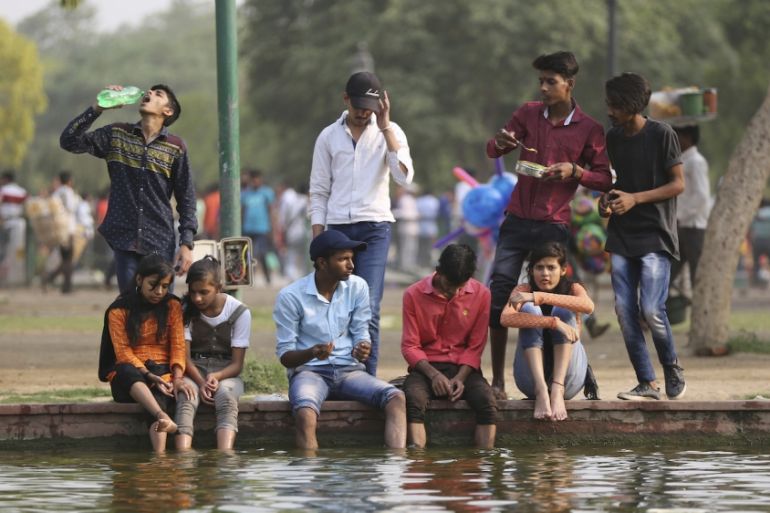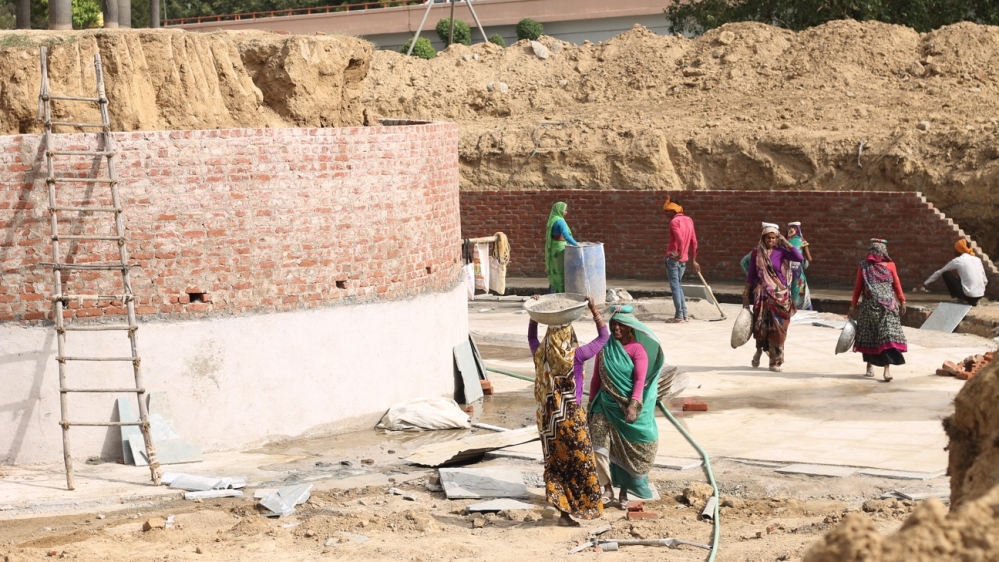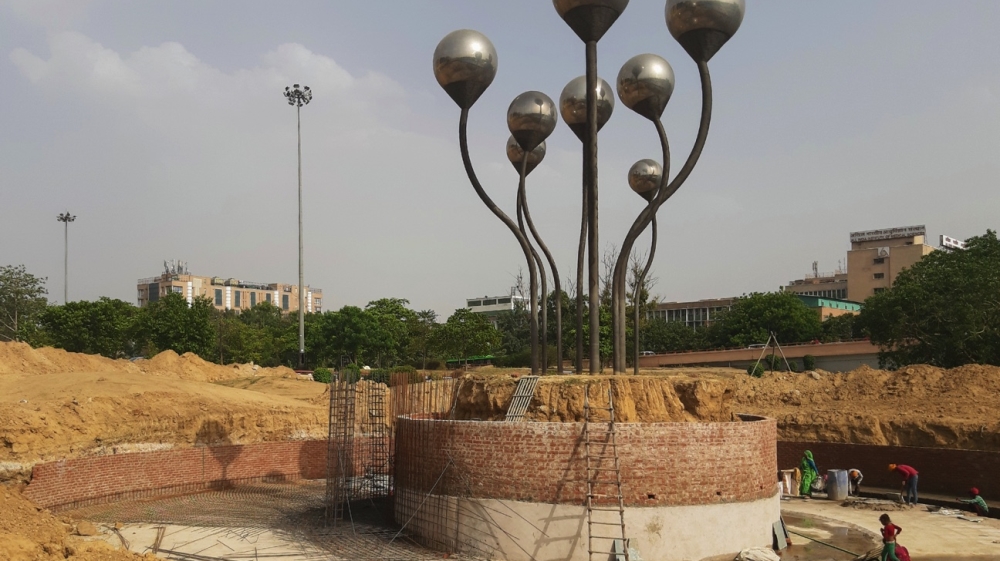Indian summer: Why heat waves are bad for people and the economy
The failure of past governments to create enough jobs has left India vulnerable to climate change effects, analysts say.

On a recent afternoon in New Delhi, as the temperature touched 45 degrees Celsius during one of India‘s worst heat waves in decades, a construction site supervisor watched while a group of workers, mostly women, filed past him carrying loads of fresh concrete on their heads.
“We’re building a fountain,” the supervisor, Kalicharan (who only goes by one name) told Al Jazeera. “It‘s not possible to continue work in so much heat,“ he said, as he sent the workers off for a long break. “It‘s getting worse with every year.“
Keep reading
list of 4 itemsPhotos: Death toll rises to 78 amid Brazilian storms and floods
At least 75 killed, more than 100 others missing in Brazil floods
Pakistan records ‘wettest April’ in more than 60 years
The local government had commissioned the new fountain as an addition to a contemporary art installation in the heart of the Indian capital: an 11-metre-tall stainless steel structures spread over 2.4 hectares of landscaped gardens surrounded by winding flyovers. The artist, Vibhor Sogani, had envisioned the structures 10 years ago as giant steel sprouts to celebrate India’s emergence as a global economic power.
But the extremely high temperatures, that have killed dozens of people across northern India and cut water supplies for millions more in recent weeks, could undermine the narrative of a rapidly growing nation that first inspired Sogani.
With unemployment near record levels and the government running a fiscal deficit, the added pressure of having to deal with the heat wave and other weather-related events could be one of the first major tests of India’s new Finance Minister Nirmala Sitharam and Prime Minister Narendra Modi in his second term.
The majority of Indian people work in areas such as agriculture and construction, making the country particularly vulnerable to extreme heat and floods. Some analysts blame decades of policymaking which have failed to create enough jobs indoors to cushion the economy and people from the changing climate.
The worst hit regions have also been among India’s poorest. In the northeastern state of Bihar, temperatures climbed to more than 45C in mid-June, killing at least 180 people this season, with local media estimating the number of deaths to be more than 300. The state government imposed a ban on construction activity between 11am and 4pm.
The situation could have been much worse. In 2015, a severe heat wave owing to a late monsoon and unusual wind patterns caused the deaths of at least 2,500 people across India.
Heating up
Heat waves – defined as a prolonged period of abnormally high temperatures for a particular region – in India have grown more intense in the last few years as climate change gains traction and creates more extreme weather events in the region.
The government has been successful in bringing down the death toll since 2015 largely because of precautionary measures and urban heat action plans. These have included building heat shelters for the homeless equipped with drinking water, installing electronic displays in public places with an early warning system and alerting medical staff to be on the lookout for early signs of heat stress.
But concerns remain about the effect of heat waves on India’s economy, which grew by a slower-than-expected 5.8 percent in the first three months of this year. While still respectable for a large economy, It was the first time India’s growth rate was slower than China’s in nearly two years.
One reason India’s economy is susceptible to events like heat waves is its large informal sector, comprising people who work with no formal contracts, including construction workers and manual farm labourers. Simply put, when it gets hot, it’s difficult, indeed dangerous, to perform heavy labour outdoors, leading many people stop working when temperatures soar.
Rising temperatures could also affect the government’s ability to lift people out of poverty, because of the effect of extreme heat on how much a person is able to produce in a given period of time, something economists refer to as productivity.
Last year, a report led by the UK-based medical journal The Lancet, involving 27 academic institutions and inter-governmental organizations, said 40 million more people were exposed to excess heat in 2016 compared with 2012.
The report also said that India alone lost close to 75 billion labour hours in 2017 due to extreme heat, about half the global total of 153 billion hours lost to extreme heat days in the same year. About 80 percent of those losses in India were in agriculture,
And a study released on Monday by the International Labour Organisation (ILO) said that by 2030, India would lose 5.8 percent of its working hours to heat stress as average global temperatures rise, equivalent to 34 million full-time jobs out of a total of 80 million globally.

The ILO’s report also says that a growing number of working hours will be lost in the construction industry, which absorbs millions of internal migrant workers every year.
India’s joblessness problem is already chronic. Last year, unemployment hit a 45-year high of 6.1 percent.
“I have been working in the construction sector [for decades]. I don’t think we can get the same amount of work done as before,” Kalicharan said, blocking the sun from his face with the back of his hand. “Productivity has declined over time.”
As the livelihoods of people like Kalicharan and others in the informal sector suffer, they are likely to buy fewer goods. Consumer demand is a major driver of India’s economic growth.
In 2017, the government said that extreme weather events cost the Indian economy between $9bn and $10bn annually, and a new study by Stanford University estimates that climate change could have shrunk India’s economy by 31 percent since the 1960s.
“Marginal productivity of labour gets affected by lower endurance, fatigue and cognitive performance, and heat stress causes all such health effects. Studies under ergonomics have also established the strong association between productivity loss and rise in temperature,” Saudamini Das, an economist at the Institute of Economic Growth in New Delhi, told Al Jazeera.
“In India, maximum labour days come from informal sector and reduced labour supply from this sector can have a sizeable impact on the economy,” Das said.
India’s economy is nearly nine times larger than it was in 1991 when the government began liberalisation policies. But most of its workforce is still employed in the informal sector, with the ILO estimating it to be 81 percent of the total workforce.
According to Das, extreme heat conditions could have serious consequences for developing countries like India, resulting in crop and livestock losses for farmers already struggling under the weight of large debts.
“[Other consequences could be] water shortage, economic cost escalation with more energy consumption, increased household expenditure causing reduced savings [and] reduced work time,” Das says.
In a study conducted in 2015 in the eastern state of Odisha, Das found that workers with informal jobs lost close to 15 percent of labour time per day of that year’s heat wave; and low-income households spent 90-100 Indian rupees ($1.29-$1.44) more on average for every heat wave day as they tried to cope with heat stress.
“One finds the number of heat wave days to increase 2.5 times by 2020 and 3.5 times by 2030, which will put heavy burden on these people. This also means that, in general, labor markets in low-income countries are likely to be seriously affected in terms of both labor supply and wellbeing of the labor class,” Das wrote in her study.
Farmers on the front line
Another study, this one published by The Council on Energy, Environment and Water (CEEW), estimated that the persistence of heat waves in India could reduce labour productivity in agriculture by up to two percent affecting millions of subsistence farmers.
“This will impact farmers and may accentuate farm distress and poverty. However, it is often difficult to quantify the impact of [extreme] heat alone as several factors contribute to poverty,” Hem Dholakia, a senior associate at CEEW, told Al Jazeera.
The recently released Fifth Assessment Report by the Intergovernmental Panel on Climate Change (IPCC) has warned of dire consequences if the trends in global warming are not reversed and the average global temperature rises by 1.5 Celsius. The report puts India among the most vulnerable regions, citing its low per capita income, inequality and heavy reliance on agriculture.

According to a study published last year in the journal Climate Policy, progress on poverty alleviation in the developing world “would be impossible without [a] sustained increase in labour productivity.”
But that increase has failed to materialise in India. Data compiled by research firm CEIC shows that the growth in labour productivity peaked in 2010 and has been on a downward trend since.
Another problem exacerbating the effects of climate change is India’s weak manufacturing sector.
Since reforms began in 1991, this part of the economy has grown very slowly. Government figures show that factories make a relatively small contribution to India’s economy, accounting for less than 17 percent of economic output, slightly less than agriculture’s share.
By contrast, services make up nearly 54 percent, only slightly below what they contribute to the economy of China, whose per-capita income is roughly five times bigger.
Government policies in places like China and other Asian emerging economies have facilitated the shift of labour from fields and building sites to factories and offices. But past governments in India have attempted to skip the manufacturing phase of the country’s development and invested heavily in areas such as information technology, creating high value jobs, but not enough of them to absorb large numbers of poorly educated people.
As a result close to 81 percent of the workforce remains engaged in the informal economy, most likely exposed to the elements.
Many experts see the threat of climate change and extreme heat days to the vast informal workforce as a consequence of this structural flaw in the economy.
“The reason why people are forced to engage in informal employment which exposes them to heat is poverty and the lack of human and development through health and education. Climate change and its impacts (such as heat waves) provide a perfect opportunity for policymakers to hide behind nature [and] blame climate change for deaths,” Lydia Powell, head of the Centre for Resources Management at the Observer Research Foundation, told Al Jazeera.
According to Powell, economic development can drive climate change, but can also act to mitigate its effects on people: “Even if emissions are reduced to zero today by all countries in the world the climate-related events such as heat waves and drought will not stop,” Powell said. “The real policy challenge for India is to enhance human ability so that no one has to slog outside exposed to climate change.”